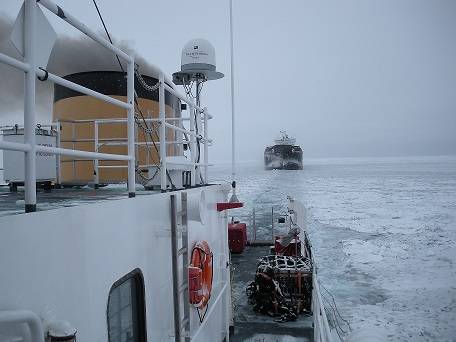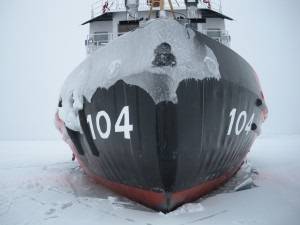Logistics in Action: Keeping Cargo Moving
Although much of the country is welcoming spring and the warm weather that comes with it, many of the Great Lakes waterways are still laden with ice. Coast Guard icebreaking tugs continue to work on the lakes to keep critical shipping lanes clear for merchant vessels, remove hazardous obstructions to navigation and free ships stuck in ice. Their mission sustains a bi-national economy and keeps maritime crews safe.
This year’s icebreaking season has been a busy one filled with successful missions and a few unexpected challenges. One of the latter was a major electrical failure on board the icebreaking tug Biscayne Bay, homeported in St. Ignace, Mich. While this would be a lofty challenge to overcome, the centralized depot maintenance – resulting from modernization of the Coast Guard’s Surface Forces Logistics Center – repaired Biscayne Bay in a record 44 days.
An ice breaker breaks down
It’s a nightmare for every ship’s crew: the ship breaks, you don’t have the parts on board to fix it and you can’t complete your mission. Coast Guard engineers train and labor for thousands of hours, working day in and day out to maintain proficiency and keep the ship running. Crews take immense pride in their work, but some casualties are big enough they need to entrust their ship into someone else’s hands for repair.
Biscayne Bay suffered a catastrophic casualty Jan. 2, 2013, in the frozen Straits of Mackinac, Mich., preventing the cutter from completing its primary missions. As one of nine cutters expected to perform the domestic icebreaking mission alongside other U.S. and Canadian icebreaking cutters in the Great Lakes, the casualty threatened to relegate the ship and its crew to the sidelines.
Single point of contact, 24/7 support
Biscayne Bay reported the casualty to the Icebreaker, Buoy and Construction Tender Product Line in Baltimore, Md., where they quickly sprang into action. Naval Engineering Support Unit Cleveland sent a maintenance augmentation team to test Biscayne Bay’s main motor while the ship’s crew anxiously awaited the news. The results were exactly what they feared: Biscayne Bay’s main motor armature was broken.
The 140-foot tug class is a single-shaft cutter powered by one main motor. Suffering a casualty to a component of the main motor impairs the Biscayne Bay’s ability to get underway on its own power, rendering the tug not fully mission capable.
Taking a week, the Michigan-based Coast Guard Cutter Mackinaw escorted the wounded tug south through frigid Michigan waterways to Sector Detroit. That was the easy part. Any seafarer knows critical repairs require extensive skill, knowledge and patience by engineers, contractors and ship’s crew. And every day the Biscayne Bay sat at the pier meant another day the rest of the region’s cutters would shoulder an increased workload to keep cargo moving across the lakes.
Communication and coordination
The geographically dispersed SFLC communicated and coordinated rapidly. The industrial operations division in Norfolk, Va., tasked Industrial Production Facility Detroit with preparatory work to remove the main motor. Tradesmen cut a hole in Biscayne Bay’s deck, disassembled the main motor and worked with the ship’s crew to remove the broken machinery on Jan. 24.
While the engine was taken apart and removed in Detroit, the SFLC contracting staff secured a commercial vendor and scheduled shipment of the armature for refurbishment by an Ohio motor repair contractor.
Thanks to seamless coordination between several SFLC offices across the United States, the original armature was repaired within a week and returned to Detroit for installation on Feb. 1. Engineers completed operational tests on the main motor and ensured compliance with safety standards. IPF Detroit tradesmen welded the hole through which the armature had been removed. On Feb. 12, the Biscayne Bay departed for sea trials and three days later, the ship returned to its duties.
In just 44 days, the SFLC restored an incapacitated Coast Guard asset to a fully functional icebreaking tug. When the ship’s commanding officer, Lt. Tom Przybyla, looked at his boat and thought of what was so quickly accomplished, he swore he saw Biscayne Bay smiling, happy to be back breaking ice on Michigan’s waterways.
Story from the Coast Guard Compass, official blog of the U.S. Coast Guard: coastguard.dodlive.mil


















